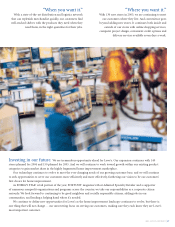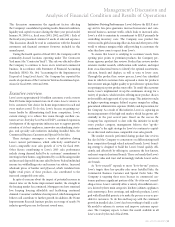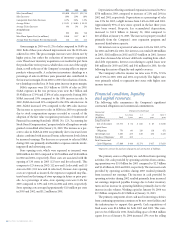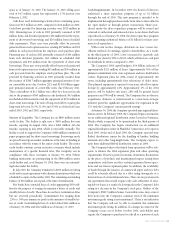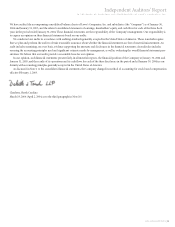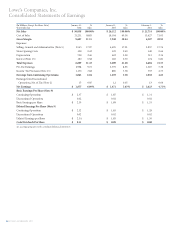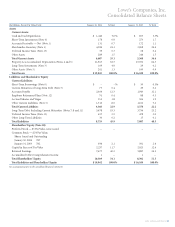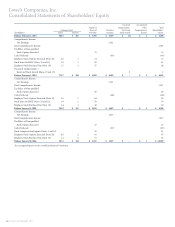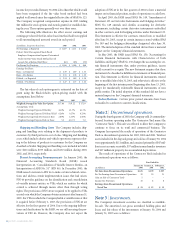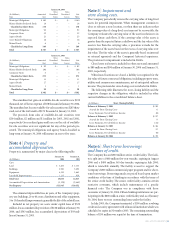Lowe's 2003 Annual Report Download - page 26
Download and view the complete annual report
Please find page 26 of the 2003 Lowe's annual report below. You can navigate through the pages in the report by either clicking on the pages listed below, or by using the keyword search tool below to find specific information within the annual report.
24 LOWE’S COMPANIES, INC.
holder’s notes. The Company may redeem for cash all or a portion
of the notes at any time beginning October 2006, at a price equal
to the sum of the issue price plus accrued original issue discount
and accrued cash interest, if any, on the redemption date. The
Company’s debt ratings at January 30, 2004 were as follows:
Current Debt Ratings S&P Moody’s Fitch
Commercial Paper A1 P1 F1
Senior Debt A A2 A
Outlook Positive Stable Stable
Company outlook.
During fiscal 2004, the Company expects to open 140 stores,
resulting in total square footage growth of approximately 14%.
The Company expects total sales to increase approximately 17%
and comparable store sales to increase 5% to 6%. Including the
estimated 50 basis point negative impact of adopting EITF 02-16,
operating margin is expected to decline 20 to 30 basis points. In
addition, store opening costs are expected to be approximately
$137 million. Including the estimated $0.13 per share negative
impact of adopting EITF 02-16, diluted earnings per share of $2.63
to $2.66 are expected for the fiscal year ending January 28, 2005.
Excluding the impact of adopting the accounting change, diluted
earnings per share of $2.76 to $2.79 would be expected.
Quantitative and qualitative disclosures
about market risk.
The Company’s major market risk exposure is the potential loss
arising from the impact of changing interest rates on long-term
debt. The Company currently only has fixed rate debt. The
Company’s policy is to monitor the interest rate risks associated
with this debt, and the Company believes any significant risks
could be offset by available variable rate instruments available
through the Company’s lines of credit. The following tables sum-
marize the Company’s market risks associated with long-term
debt, excluding capital leases. The tables present principal cash
outflows and related interest rates by year of maturity, excluding
unamortized original issue discounts as of January 30, 2004 and
January 31, 2003. The fair values included in the following tables
were determined using quoted market rates or interest rates that
are currently available to the Company on debt with similar terms
and remaining maturities.
Long-Term Debt Maturities by Fiscal Year
January 30, 2004
Average Average
Fixed Interest Variable Interest
(Dollars in Millions) Rate Rate Rate Rate
2004 $ 54 7.98% $ – –
2005 608 7.32 – –
2006 8 7.70 – –
2007 61 6.89 – –
2008 6 7.39 – –
Thereafter
3,036 4.49% – –
Total
$ 3,773 $ –
Fair Value
$ 3,985 $ –
Long-Term Debt Maturities by Fiscal Year
January 31, 2003
Average Average
Fixed Interest Variable Interest
(Dollars in Millions) Rate Rate Rate Rate
2003 $ 8 7.64% $ – –
2004 55 7.98 – –
2005 609 7.32 – –
2006 8 7.70 – –
2007 61 6.89 – –
Thereafter
3,042 4.49% – –
Total
$ 3,783 $ –
Fair Value
$ 3,747 $ –





